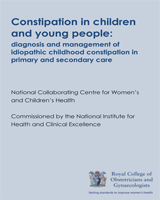| Timing of onset of constipation and potential precipitating factors | In a child younger than 1 year:
Starts after a few weeks of life
Obvious precipitating factors coinciding with the start of symptoms: fissure, change of diet, infections
In a child/young person older than 1 year:
Starts after a few weeks of life
Obvious precipitating factors coinciding with the start of symptoms: fissure, change of diet, timing of potty/toilet training and acute event such as infections, moving house, starting nursery/school, fears and phobias, major change in family, taking medicines | Reported from birth or first few weeks of life |
| Passage of meconium | Normal (within 48 hours after birth [in term baby]) | Failure to pass meconium/delay (more than 48 hours after birth [in term baby]) |
| Stool patterns | | ‘Ribbon stools’ (more likely in a child younger than 1 year) |
| Growth and general wellbeing | In a child younger than 1 year:
Generally well, weight and height within normal limits
In a child/young person older than 1 year:
Generally well, weight and height within normal limits, fit and active | No ‘red flag’, but see ‘amber flag’ below. |
| Symptoms in legs /locomotor development | No neurological problems in legs (such as falling over in a child/young person older than 1 year), normal locomotor development | Previously unknown or undiagnosed weakness in legs, locomotor delay |
| Abdomen | | Abdominal distension with vomiting |
| Diet and fluid intake | In a child younger than 1 year:
Changes in infant formula, weaning, insufficient fluid intake
In a child/young person older than 1 year:
History of poor diet and/or insufficient fluid intake | |
‘Amber flag’, possible idiopathic constipation
Growth and general wellbeing:
Personal/familial/social factors:
|
